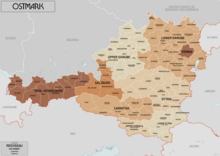Ostmark (Austria)
| Ostmark | |||||||||
|---|---|---|---|---|---|---|---|---|---|
| Reichsgau of Nazi Germany | |||||||||
| 1938–1939 | |||||||||
| Capital | Vienna | ||||||||
| Government | |||||||||
| Reichsstatthalter | |||||||||
• 1938–1939 | Arthur Seyss-Inquart | ||||||||
| History | |||||||||
• Established | 1938 | ||||||||
• Disestablished | 1939 | ||||||||
| |||||||||

Ostmark (German pronunciation: [ˈɔstmaʁk] ⓘ, "Eastern March") was a name that referred historically to the Margraviate of Austria, a medieval frontier march. It was also used in Nazi propaganda from 1938 to 1942 to refer to the formerly independent Federal State of Austria after the Anschluss with Nazi Germany. From the Anschluss until 1939, the official name used was Land Österreich ("State of Austria").[1]
History
Once Adolf Hitler completed the union between Austria and Germany (Anschluss), the Nazi government renamed the incorporated territory. The name Austria (Österreich in German, meaning "Eastern Realm") was at first replaced by "Ostmark", referring to the 10th century Marcha orientalis. The change was meant to refer to Austria as the new "eastern march" of the Reich.
In August 1938, the Donau-Zeitung proudly referred to Passau as "the cradle of the new Ostmark".[2]
Subdivisions
According to the Ostmarkgesetz with effect from 1 May 1939, the former States of Austria were reorganized into seven Reichsgaue of the German Reich, each under the rule of a government official holding the dual offices of Reichsstatthalter (governor) and Gauleiter (Nazi Party leader):[3]
- Carinthia, including East Tyrol; increased by Slovenian Carinthia and Upper Carniola as occupied territories after the 1941 Balkans Campaign
- "Lower Danube" (Niederdonau), name for Lower Austria, with its capital at Krems an der Donau, including the northern districts of Burgenland with Eisenstadt, the South Moravian territories around Znojmo (Deutsch-Südmähren) annexed with the Sudetenland according to the 1938 Munich Agreement and also the Bratislava boroughs of Petržalka (Engerau) and Devín (Theben)
- Salzburg
- Styria, including the southern districts of Burgenland; increased by Lower Styria as occupied territory after the 1941 Balkans Campaign
- "Upper Danube" (Oberdonau), name for Upper Austria, including the Styrian Aussee region (Ausseerland) and the South Bohemian territories around Český Krumlov annexed with the "Sudetenland" according to the 1938 Munich Agreement
- Tyrol, i.e. North Tyrol, with the administrative district of Vorarlberg
- Vienna, i.e. "Greater Vienna", including several surrounding Lower Austrian municipalities incorporated in 1938.
A Reichsgau was a new, simple administrative sub-division institution which replaced the federal states in the otherwise completely centralized Third Reich.[4] From April 8, 1942, as the term "Ostmark" was still too reminiscent of the old, independent state of Austria, the chosen official name for the seven entities was Alpen- und Donau-Reichsgaue ("Danubian and Alpine Reichsgaue"). In the course of the Allied occupation after World War II, the Austrian state was restored in its pre-1938 borders according to the 1943 Moscow Declaration.
References
- ^ Eckart Reidegeld: Staatliche Sozialpolitik in Deutschland. Band II: Sozialpolitik in Demokratie und Diktatur 1919–1945, 1. Aufl., VS Verlag, Wiesbaden 2006, ISBN 3-531-14943-1, S. 406, 542.
- ^ Rosmus, Anna (2015). Nibelungen: Niederbayern im Aufbruch zu Krieg und Untergang [Hitler's Nibelungs: Lower Bavaria at the Onset of War and Downfall] (in German). Grafenau, Germany: Simone Samples Verlag. p. 165f. ISBN 978-3-9384-0132-3.
- ^ "legal text at verfassungen.de" (in German). Archived from the original on 2017-11-12. Retrieved 2010-08-11.
- ^ "reconciliationfund". Archived from the original on 2011-07-06. Retrieved 2009-08-04.
See also

